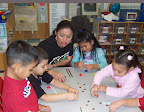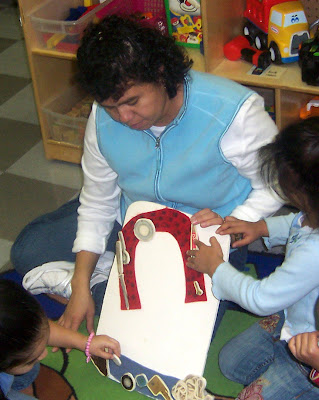Playing with magnets and learning about the property of materials
By Peggy Ashbrook
Posted on 2008-12-07
 Playing with magnets is a useful science activity in early childhood classrooms because it fosters conversation, exploration of materials, and learning to make predictions. Making a prediction means focusing on what you think will happen next based on your prior knowledge. We can help children develop this the skill of predicting (or guessing if there is no prior knowledge) what might happen any time we read to them, by asking them to predict what will happen next in the story. (See the discussion about the words “prediction” and “hypothesis”, in When a Hypothesis is NOT an Educated Guess by Louise M. Baxter and Martha J. Kurtz in Science & Children, April 2001, pg 18-20.)
Playing with magnets is a useful science activity in early childhood classrooms because it fosters conversation, exploration of materials, and learning to make predictions. Making a prediction means focusing on what you think will happen next based on your prior knowledge. We can help children develop this the skill of predicting (or guessing if there is no prior knowledge) what might happen any time we read to them, by asking them to predict what will happen next in the story. (See the discussion about the words “prediction” and “hypothesis”, in When a Hypothesis is NOT an Educated Guess by Louise M. Baxter and Martha J. Kurtz in Science & Children, April 2001, pg 18-20.)
Preschool teacher Ms. Kim reads a book aloud to her class and they respond with their predictions.
She encourages participation by making it clear that she wants the children to make the predictions and that she will respect and accept all answers (and not provide any). Any book will do but Fortunately by Remy Charlip, is a great book for getting children started thinking about what will happen next, noticing patterns and asking questions. After reading Ms. Kim followed up by asking the children if things turned out the way they thought it would (spoiler alert—it has a happy ending).
 Prior experience informs learning, so I try to expose children to many materials and the opportunity to manipulate them. While examining all the objects and testing their attraction to a magnet the children are talking, gaining language and social skills while doing science. (Click on the photo to see a larger view.)
Prior experience informs learning, so I try to expose children to many materials and the opportunity to manipulate them. While examining all the objects and testing their attraction to a magnet the children are talking, gaining language and social skills while doing science. (Click on the photo to see a larger view.)
 This week I’ve seen children building with the objects, creating a microphone with the ubiquitous preschool magnets with a handle, and delighting in possessing key or coin—objects of power so I include enough for every child. Using magnets in many shapes and sizes helps children understand that the property of magnetism is in the material, not a size, shape, or color. In the small science groups it is easier to note what is said and what happens, and assess each child’s understanding.
This week I’ve seen children building with the objects, creating a microphone with the ubiquitous preschool magnets with a handle, and delighting in possessing key or coin—objects of power so I include enough for every child. Using magnets in many shapes and sizes helps children understand that the property of magnetism is in the material, not a size, shape, or color. In the small science groups it is easier to note what is said and what happens, and assess each child’s understanding.
 After experiencing the force of magnetism using a variety of magnets and materials, children are ready to predict which objects will be attracted to a magnet.
After experiencing the force of magnetism using a variety of magnets and materials, children are ready to predict which objects will be attracted to a magnet.
Children can represent their understanding using a small set of new objects (at first without a magnet) and photocopies of those objects. The children represented their predictions by putting photocopied pictures of the objects either on the magnet picture (“magnet will attract the object”) or on the dish picture (“magnet will not attract the object”). Then they each tested an object using a magnet.
.jpg) There is often disagreement among the children about whether or not an object will be attracted to the magnet. I use this as an opportunity to tell them that scientists don’t always agree on what they think will happen.
There is often disagreement among the children about whether or not an object will be attracted to the magnet. I use this as an opportunity to tell them that scientists don’t always agree on what they think will happen.
Even though they had experience with a magnet and a variety of metal objects, many children were still surprised when a brass key was not attracted to the magnet. This is a common misconception among the teachers as well, that magnets will attract all metals. Through experience the students learn that a magnet will never attract certain materials, and always attract others—metals but not all metals. Understanding why that is will have to wait until they are older, but by repeating the activity children come to know that each object reacts to the magnet the same way each time, and that this is part of the nature of the material. Magnet Man, offers much more on this subject on his website.
After testing the actual objects with a magnet, the children changed their arrangement of the photocopies of the objects as needed to represent the results rather than their predictions.
Peggy
Disclaimer: The views expressed in this blog post are those of the author(s) and do not necessarily reflect the official position of the National Science Teaching Association (NSTA).


